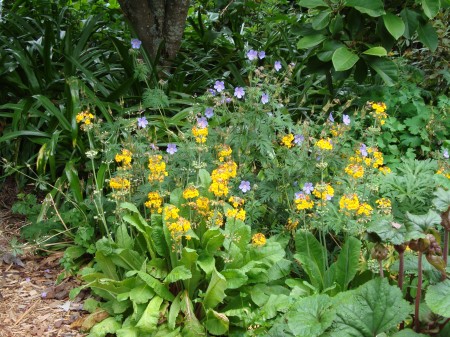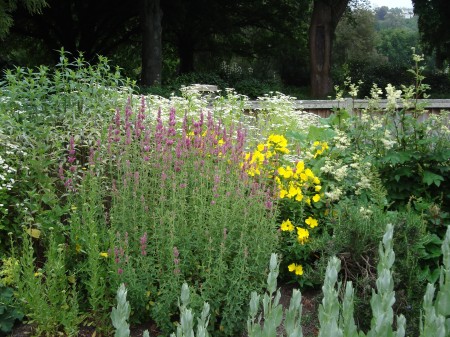Inflammation of the skin as in Dermatitis can be remedied by avoiding those irritants which cause dermatits, by applying herbal remedies to the skin, and by correcting the diet. Homeopathy can be a great help in helping to cure skin conditions, but of course, it is imperative that you avoid exposure to the chemicals which usually cause the problem of dermatitis. Herbs For Healing: Photo taken at Dunedin Botanical Gardens NZ. Merrilyn took the photo on Holly’s camera December 2012.
Herbs For Healing: Photo taken at Dunedin Botanical Gardens NZ. Merrilyn took the photo on Holly’s camera December 2012.
The main thing is to avoid using detergents and dish washing liquids: Most of these are derived from petroleum products which dry out the skin terribly. Petroleum compounds, as used in detergents and other household products, are absorbed through the pores of the skin and contribute, along with many other chemicals in food, cosmetics, and our environment, to cancer and other degenerative disease. A skin condition of ill-health is to be taken as a warning sign that something is wrong. No use going to take steroids and other such drugs which only mask the real problem: The irritant cause has to be dealt with if you want to protect your general health.
People with sensitive skins usually suffer when their hands are put into a sink full of water containing detergent. Washing powder for the clothes can also be the cause of skin inflammation, so watch out for those. If you have a problem with eczema, or dermatitis, then you should use pure ‘Lux’ soapflakes, or pure ‘Sunlight’ soap for your dishes, as well as for your clothes-wash. You should also use rubber gloves to protect your skin, even if you use pure soap flakes in your dish washing water. If your hands are in a bad way, then use cotton gloves inside the rubber gloves, to line them. Alternatively, get someone else to wash those dishes. You can do the drying….
Babies often get a rash for no good reason – the answer is usually to stop using soap powders which contain irritating chemicals. Just grate up a suitable amount of pure soap for using in your washing machine, if you cannot buy pure soap flakes.
The book called ‘Successful Herbal Remedies’, written by Nalda Gosling, 1985, suggests that the best herbal remedies for dermatitis are Chickweed ointment, or slippery elm or marshmallow ointment. One of these should be applied morning and night. She also recommends supplements of 2,500 IU of Vitamin A daily, as well as extra B complex and extra vegetable oil. Nalda Gosling also recommends the herbs Echinacea and Blue Flag Root for helping skin conditions. These could be taken in a herbal pill form as per instructions on the label.
Homeopathic Remedies which might help dermatitis of the skin are Echinacea, Thuja, Mercurius, or Sulphur. Any one of these will help the body to detoxify, which will, in turn, help the skin to heal. I can recommend the Weleda combination homeopathic medicine which has Thuja and Echinacea, together with some other herbs. This is a fanatastic tonic for helping people who are suffering candida, yeast infection, or who have been exposed to vaccinations or other chemicals which have affected the immune system. Follow the instructions as given by Weleda.
A daily dose of one dessertspoonful of sunflower oil will supply essential fatty acids, Vitamin E, and other nutrients which will help the skin to stay healthy. Alternatively, try to include plenty of sunflower seeds and sesame seeds in your diet. Almonds are also helpful.
Castor Oil to Detoxify: Taking a couple of tablespoons of Castor Oil once a week will help your body to detoxify. This will help the condition of the skin.
Castor Oil Pack: A warm castor oil pack which is left on the abdomen overnight, or for at least 3 hours, will also help the body to detoxify. This treatment is best applied for 3 days in a row, then left for 3 days, according to Walter Last’s recommendation to me many years ago. I have found the castor oil pack to be enormously helpful in curing digestive problems, and in detoxifying the body. It is easy to do – Use a small piece of white cotton or linen or wool, and pour over a couple of tablespoons of Castor oil. I put this straight onto the abdomen with a small plastic bag over the top and a hot water bottle on top of that. It is important to use a clear plastic, or a white plastic, with no coloured writing on it, otherwise the colour on the plastic, or contained within the plastic, will come off onto your castor oil pack. This will ruin it, as then you will have unwanted chemicals on your pack.
The pack can be used again. Just top up with a teaspoon or two of oil as needed.
Diet To Help Skin Conditions: Avoid all processed foods and all foods containing preservatives, colourings, or flavourings. An alkaline diet which is rich in fresh green salads, with grated raw carrot, and enough protein from meats, sunflower seeds, sesame seeds, almond, and coconut, is helpful. It is best to avoid wheat products, and dairy products, and sugar, until your skin is better. Then you can establish whether or not you are allergic to any of these foods, as when you re-introduce them again, you will get a reaction if they are no good for you.
Also avoid any foods which have yeast in them, such as bread, vinegar, wines, beer, soy sauce, etc. Yeasts encourage candida in the body, which causes yeast problems. Skin troubles can be a sign of candida overgrowth. So – stick to the alkaline diet, with plenty of raw green salads, with cooked greens as well, rice, potatoes, and protein of various sorts except for milk and dairy, and you should see an improvement.
If your skin is not better after a week or two of following a programme such as this, then you most certainly need to see a professional health expert, if you haven’t already done so.

